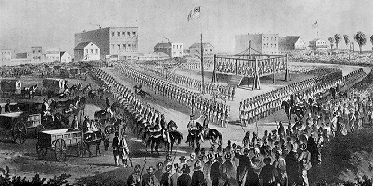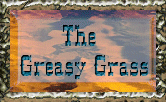Dakota Commemorative March

The hanging
of 38 Dakota men on December 26 1862 Minnesota
Historical Society
Trials of the Dakota after the War of 1862 (2)
Case
3: We-chank-wash-to-do-pee The Military Commission met pursuant to the above order Present Col Brooks 6th Regt. to M.V.Members Lt. Col. Marshall 7th Regt. to M.V.Capt. Grant 6th Regt. to M.V.Capt. Bailey 6th Regt. to M.V.Lt. Olin 3d Regt. to M.V.Judge Advocate Adjutant Heard McPhail's Mounted Rangers Recorder The Military Commission was then duly sworn and We-chank-wash-to-do-pee a Sioux Indian was arraigned on the following charges and specifications. viz -- Charge and specification against We-chank-wash-to-do-pee, a Sioux Indian--- - Charge - - Murder - Specification
- In this that the said We-chank-wash-to-do-pee, Sioux Indian
did, on or about the 18th day of August 1862, kill George H.
Gleason, a white citizen of the United States, and has likewise
committed sundry hostile acts against the whites between the
said 18th day of August 1862, and the 28th day of September
1862. This near the Red Wood River, and at other places on the
Minnesota frontier. Witnesses -Comd'g Mil. Expedition Sarah Wakefeild (sic) Angus Robertson S.H. Fowler. Lt. Coe - State Militia A.A. Ajt. And thereupon the prisoner being asked what he had to say in answer to said charge made the following statement. I plead not guilty of murder. The other Indian shot Gleason, and as he was falling over I aimed my gun at him but did not fire -- I have had a white woman in charge but I could not take as good care of her as a white man because I am an indian -- I kept her with the intention of giving her up --- Don't know of any other bad act since Gleason was murdered -- I moved up here with the indians -- If I had done any bad act I should have gone off -- I was present when the white man was killed. There were two in the war party who killed Gleason -- The other indian was not a relative of mine. The other Indian fired twice -- The other Indian said "Brother-in-law lets shoot him". He had already shot at him. I aimed at him because I was told I must kill the whites to save myself -- I have been in three battles. I have not fired at any other white man -- I wanted to prevent the other Indians from shooting -- I prevented him from killing the women and children with Gleason -- I snapped my gun at Gleason, but it failed to go off -- I shot over Gleason when he fell -- This was the third shot. I afterward snapped at him when he was dead on the ground. Sarah Wakefeild (sic), a witness on the part of the prosecution, being them in the court was called, and after being duly sworn testified as follows-- I was with Mr. Gleason when he was killed -- Myself and two children were riding with him -- There were two in the party who attacked us-- The indians were coming up from the direction of the Lower Agency -- The other man shot Mr. Gleason. This man tended the horses -- When the shots were fired the horses ran and he caught them -- The indian was near the wagon when he fired -- He shot both barrels and loaded up while this indian ran after the horses -- When Mr. Gleason was in his death agony this indian snapped his gun at him -- He afterwards told me that it was to put him out of his misery -- I saw this indian endeavor to prevent the other indian from firing at me -- He raised his gun twice to do it -- He said he did not go into this thing willingly -- The pipe I spoke of yesterday I have since heard belonged to a white man who was killed and that he (the prisoner) felt so bad about it he didn't care whether he was killed, or not, in this war and that was why he was in it -- Jo. Reynolds knows him very well and considers him a fine man -- He had on leggins at the time Gleason was shot -- When we got in, he took me from a tepee where it was cold, with my babes to one where there was a white woman -- Since then he has saved my life three times. When this indian prevented the other indian from killing me, the others wanted to kill my children, saying "they were no use" and this indian prevented it -- I have never known him to go away but twice - He went only when he was freed to go and expressed great feeling for the whites. His mother took me in the woods and kept me when my life was threatened. He saved my life once, when Shakopee the chief of his band tried to kill me -- This indian has no plunder in his tent. They are very poor, he and his family-- They have had to beg victuals for me and he has given his coffee and food to my children and gone without himself. He is a very generous man. I have seen him give away his own shirt to indians. Angus Robertson, another witness for the prosecution, being then called and duly sworn, testified as follows: I heard the prisoner say before Mrs. Wakefeild that he fired the second shot -- He said his brother in law wanted to kill Mrs. Wakefeild and her children, but he prevented it -- He said he shot Gleason didn't kill Gleason -- This indian is a very good indian -- His conduct has been uniformly good towards Mrs. Wakefeild and her children. The testimony being closed the Commission was then closed and provided both finding and sentence. The Military Commission after mature deliberation on the testimony adduced find the prisoner as follows-- Guilty of the specification of the first charge. Guilty of the first charge -- Guilty of the specification of the second charge. Guilty of the second charge -- and do therefore do sentence him the said We-chank-wash-to-do-pee, a Sioux Indian to be hung by the neck until he is dead. We certify that the foregoing are the minutes of the proceedings and testimony on the annexed charge, under order No. 55 of Col. H. H. Sibley. I. V. D. Heard} Recorder } [Signed by the five members of the Commission] This man is also known as Chaska, and is written about in great detail in the book by Sarah F. Wakefield, 'Six weeks in the Sioux Tepees'.
|


